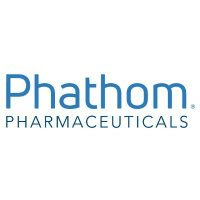
Phathom Pharmaceuticals Inc
NASDAQ:PHAT


| US |

|
Johnson & Johnson
NYSE:JNJ
|
Pharmaceuticals
|
| US |

|
Berkshire Hathaway Inc
NYSE:BRK.A
|
Financial Services
|
| US |

|
Bank of America Corp
NYSE:BAC
|
Banking
|
| US |

|
Mastercard Inc
NYSE:MA
|
Technology
|
| US |

|
UnitedHealth Group Inc
NYSE:UNH
|
Health Care
|
| US |

|
Exxon Mobil Corp
NYSE:XOM
|
Energy
|
| US |

|
Pfizer Inc
NYSE:PFE
|
Pharmaceuticals
|
| US |

|
Palantir Technologies Inc
NYSE:PLTR
|
Technology
|
| US |

|
Nike Inc
NYSE:NKE
|
Textiles, Apparel & Luxury Goods
|
| US |

|
Visa Inc
NYSE:V
|
Technology
|
| CN |

|
Alibaba Group Holding Ltd
NYSE:BABA
|
Retail
|
| US |

|
3M Co
NYSE:MMM
|
Industrial Conglomerates
|
| US |

|
JPMorgan Chase & Co
NYSE:JPM
|
Banking
|
| US |

|
Coca-Cola Co
NYSE:KO
|
Beverages
|
| US |

|
Walmart Inc
NYSE:WMT
|
Retail
|
| US |

|
Verizon Communications Inc
NYSE:VZ
|
Telecommunication
|
Utilize notes to systematically review your investment decisions. By reflecting on past outcomes, you can discern effective strategies and identify those that underperformed. This continuous feedback loop enables you to adapt and refine your approach, optimizing for future success.
Each note serves as a learning point, offering insights into your decision-making processes. Over time, you'll accumulate a personalized database of knowledge, enhancing your ability to make informed decisions quickly and effectively.
With a comprehensive record of your investment history at your fingertips, you can compare current opportunities against past experiences. This not only bolsters your confidence but also ensures that each decision is grounded in a well-documented rationale.
Do you really want to delete this note?
This action cannot be undone.

| 52 Week Range |
6.21
19.5
|
| Price Target |
|
We'll email you a reminder when the closing price reaches USD.
Choose the stock you wish to monitor with a price alert.

|
Johnson & Johnson
NYSE:JNJ
|
US |

|
Berkshire Hathaway Inc
NYSE:BRK.A
|
US |

|
Bank of America Corp
NYSE:BAC
|
US |

|
Mastercard Inc
NYSE:MA
|
US |

|
UnitedHealth Group Inc
NYSE:UNH
|
US |

|
Exxon Mobil Corp
NYSE:XOM
|
US |

|
Pfizer Inc
NYSE:PFE
|
US |

|
Palantir Technologies Inc
NYSE:PLTR
|
US |

|
Nike Inc
NYSE:NKE
|
US |

|
Visa Inc
NYSE:V
|
US |

|
Alibaba Group Holding Ltd
NYSE:BABA
|
CN |

|
3M Co
NYSE:MMM
|
US |

|
JPMorgan Chase & Co
NYSE:JPM
|
US |

|
Coca-Cola Co
NYSE:KO
|
US |

|
Walmart Inc
NYSE:WMT
|
US |

|
Verizon Communications Inc
NYSE:VZ
|
US |
This alert will be permanently deleted.
 Phathom Pharmaceuticals Inc
Phathom Pharmaceuticals Inc
Phathom Pharmaceuticals Inc
Investor Relations
Phathom Pharmaceuticals, Inc. is a clinical-stage biopharmaceutical company, which engages in the development and commercialization of novel treatments for gastrointestinal diseases. The company is headquartered in Florham Park, New Jersey and currently employs 77 full-time employees. The company went IPO on 2019-10-25. The Company’s pipeline product candidate, vonoprazan is an oral small molecule potassium-competitive acid blocker (P-CAB). P-CABs are a class of medicines that block acid secretion in the stomach. Vonoprazan has an anti-secretory effect and has demonstrated clinical benefits in the treatment of gastroesophageal reflux disease (GERD), and in combination with antibiotics for the treatment of Helicobacter pylori (H. pylori) infection. GERD and H. pylori infection are acid-related GI diseases. GERD is a disease that develops when the reflux of acidic stomach contents causes troublesome symptoms and/or complications. H. pylori is a bacterial pathogen.

Phathom Pharmaceuticals, Inc. is a clinical-stage biopharmaceutical company, which engages in the development and commercialization of novel treatments for gastrointestinal diseases. The company is headquartered in Florham Park, New Jersey and currently employs 77 full-time employees. The company went IPO on 2019-10-25. The Company’s pipeline product candidate, vonoprazan is an oral small molecule potassium-competitive acid blocker (P-CAB). P-CABs are a class of medicines that block acid secretion in the stomach. Vonoprazan has an anti-secretory effect and has demonstrated clinical benefits in the treatment of gastroesophageal reflux disease (GERD), and in combination with antibiotics for the treatment of Helicobacter pylori (H. pylori) infection. GERD and H. pylori infection are acid-related GI diseases. GERD is a disease that develops when the reflux of acidic stomach contents causes troublesome symptoms and/or complications. H. pylori is a bacterial pathogen.





























 You don't have any saved screeners yet
You don't have any saved screeners yet
